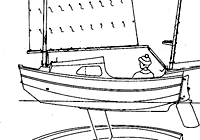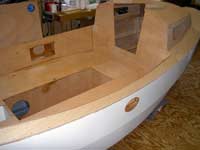“Tread
Lightly as an ultimate Daysailer”
One man’s approach to getting the boat
he wants
After selling the last boat I built during the fall
of 2005 I began looking at plans for another project.
I had discovered “Duckworks” about that
time and was interested in some of the designs of
John Welsford. I joined the Yahoo
website for Welsford design builders using the I.D.
of “onelastboat” fully intending this
next project be the last one.
After building 26 boats over a span of 50 years
I felt that I had a pretty good idea of the design
I needed at this point in my life. It was to be a
day sailor, small enough to be easily handled and
trailered, have a traditional rig, enough freeboard
to allow 2 people to comfortably sit in the boat,
and possibly have a small cabin that would allow dry
storage and possibly a “porta-pottie”,
another desirable item at this time of my life.
Soon after looking at the offerings of John Welsford,
I found the design that interested me the most was
“Tread
Lightly”. I felt that it offered
the basic conditions of design and with some modification
could be my next project. This decision led to my
purchasing a set of plans from “Duckworks”
so that I could spend some time making the modifications
that I had in mind.
After sitting down with the plans it became apparent
that the cabin could be reduced in size by moving
the cabin bulkhead forward to the next design station
thus allowing a cabin of sufficient size to accommodate
my needs.

Full Cabin |

Reduced
|
This change immediately showed that the cockpit
would be approximately 6’ 6” in length
giving me a space that would allow me to stretch out
if I want to lie down. Even though this overall length
was a pleasant surprise it was also apparent that
the design layout would not allow seats of sufficient
width to be comfortable for lying or sitting.
After some sketching and mockup work the answer was
to move the centerboard case inboard about 4”
(it was off center in the design anyway) and to increase
the width cockpit overall by a few inches on either
side. With the length and width where I wanted them
the next challenge was to see if the seats could be
lowered so that you sat down in the boat more than
sitting on top of it. The limiting factor here was
the centerboard case height.
It should be mentioned here that even though I feel
that modifications to accommodations and interior
space are up to the builders, any changes to the overall
sailing design including rig, centerboard, rudder,
hull shape and overall weight should be avoided to
be fair to the designer and not risk safety or sailing
performance. All of the modifications I accomplished
were done with this thought uppermost in my mind.
Getting back to the centerboard case, I found that
if I could move the lifting tackle which was enclosed
in the upper part of the case I could easily lower
the overall height of the case without changing the
size or position of the centerboard itself. Being
that the forward end of the case was now located at
my new cabin bulkhead the lifting tackle could exit
at the forward top of the case into the cabin and
the multipart tackle would be mounted vertically on
the inside of the cabin bulkhead.
At this point I was feeling good about how things
were coming together, but there were still some things
that I needed to address if I was going to get the
features I wanted.
The next item to work out was the propulsion system.
There will always be times when the need for some
type of engine would be welcome. I had long thought
that I would like to try to use an electric motor
and was determined to make it work in this boat.
John’s plans call for 100 kilograms of ballast
in the bottom of the boat near the design center.
This gave me the location for my battery bank, which
consisted of two deep cycle batteries. These were
housed within a bridge deck that I built at the forward
end of the cockpit. Access to the batteries was from
the inside of the cabin.
The motor was made up from an electric trolling motor
with a shortened shaft housed within a plywood box
that could be slipped into a motor well cut through
the bottom of the boat and constructed so that it
was above the waterline.
My thought was that I could if desired remove the
motor assembly and replace it with a plug of the same
size ridding the boat of the drag of the motor when
sailing.
I even worked out a storage location within the cabin
if the motor was removed for sailing. In retrospect,
I now feel that the drag is not significant and may
not go with removing the motor as I intended. At the
same time it sure is nice to be able to lift the motor
during beaching or for service if needed.
The next significant modification was doing away
with the anchor well open foredeck design feature
and sealing this and the area above the tiller at
the stern of the boat to create floatation chambers.
The entire areas of both locations were constructed
with epoxy fillets to seal them against any leakage.
Accesses to the chambers were through screw in plastic
hatches with gaskets.
The last item on my list of modifications was to
see if I could arrange for a means of rowing the boat
and building a set of oars that could fit inside the
boat under the seats. With my cockpit modifications
it became apparent that I could sit on the bridge
deck and row the boat, the problem was that the oars
would be too high if the locks were placed on the
cockpit coamings . With a little study of the problem,
it looked like I could make oar ports that were located
in the middle of the upper hull strake and entered
the cockpit in a near perfect location for the locks.
 |

|
These ports were constructed so that they were covered
with inserted panels with gaskets to seal the openings
during sailing conditions. The oars would have to
be approximately 8 ft. long to function properly so
that cutting them in half would just allow me to slide
them under the seat from within the cabin. After cutting
the oars, I epoxied a piece of 16” aluminum
tubing 8” over one of the cut ends so that this
left 8” of socket for the other end to slip
into, with a small thumbscrew to hold them together
I now had my stow able oars.
The rest of the boat was built according to the plans
of John Welsford with the only other change being
to the sail plan. Because I do not like battens in
a sail I asked to have the mizzen sail changed to
eliminate them. This was done by changing the leach
of the sail to get rid of the roach with attended
battens and lengthening the foot by 200mm to reclaim
the lost area of the roach.
The boat went together quite nicely and has proven
to be exactly what I had wanted. The sail area is
quite generous which allows spirited sailing and yet
with a couple of jiffy reefs can be subdued when the
wind conditions call for it.
The electric motor produces approx. 30 lbs. of thrust
and will move the boat in still water at about 4 mph.
It is wonderful to control with 5 forward speeds
and 3 in reverse. It was also very easy to motor sail
by adding the motor thrust to the sail when conditions
call for it. The 2 deep cycle batteries give me about
180 amp hrs. This translates into 6 hrs. operation
time at full speed at 30 amps.
The cockpit is immense for the size of the boat,
being 6’5” in length and very deep and
protected.
Although it is not self bailing the cockpit and
foot well is sealed from the rest of the boat. There
is a grating at the bottom of the footwell to raise
it off the bottom of the boat by a few inches. Under
this grating is a plastic pickup and tubing that leads
to a built in hand bilge pump that directs water out
the back of the boat.
The porta-pottie arrangement works well with reasonable
space to serve the need.
I tell interested people that I have a fully enclosed
head compartment in a 13’ boat. John Welsford,
upon seeing a picture of the head remarked, “he
could see a stack of old Readers Digests accumulating
there”.
The construction was begun in January 06 and completed
in the summer of 06 and did not allow for extensive
sailing this year because of our seasons in northern
Minnesota. We will try to follow up with a complete
long term sailing report in the future.
Bob Trygg
5923 North Shore Drive
Duluth, Minnesota 55804

|